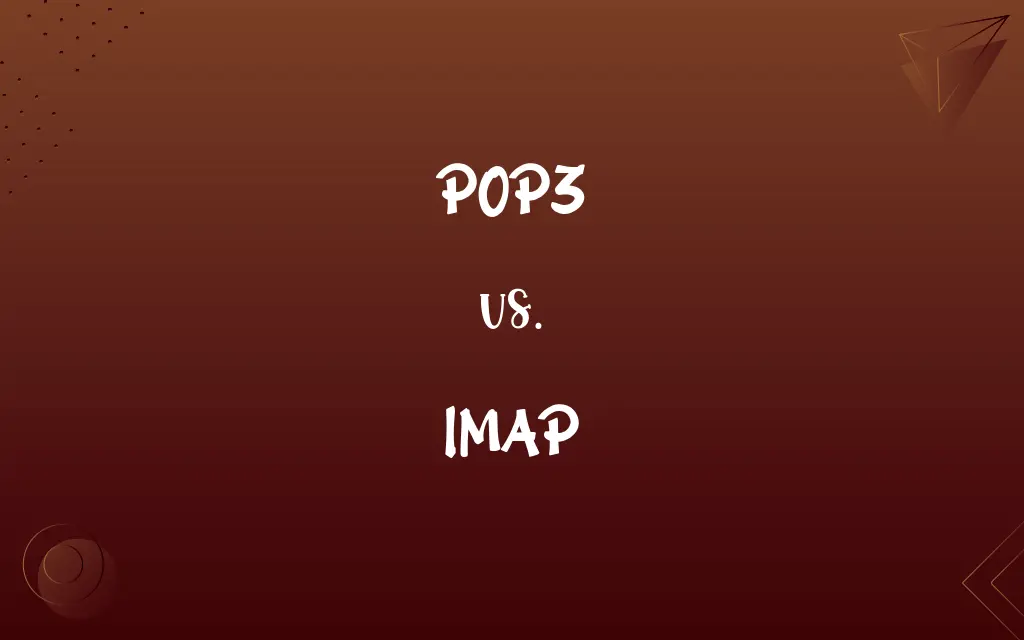POP3 vs. IMAP: Know the Difference

By Shumaila Saeed || Updated on December 25, 2023
POP3 downloads emails to a single device and deletes them from the server; IMAP syncs emails across all devices, keeping them on the server.

Key Differences
POP3, or Post Office Protocol 3, is the third version of a standard protocol for receiving email. It is designed to download emails from a mail server to a single computer and then delete them from the server. This means that once you have downloaded your email using POP3, you typically cannot access the same mail from another device. The protocol is simple and straightforward, making it suitable for basic email needs where multiple-device synchronization is not required.
Shumaila Saeed
Nov 20, 2023
IMAP, or Internet Message Access Protocol, on the other hand, allows users to access their emails from multiple devices. It is a more advanced protocol that maintains email messages on the server even after they have been accessed. This makes IMAP ideal for users who need to manage their emails from various locations or devices. With IMAP, the mail stays on the server until the user explicitly deletes it, and actions like read/unread status are synchronized across all devices.
Shumaila Saeed
Nov 20, 2023
When discussing email retrieval, POP3 offers a less complex system which may be more suited to users with a single primary device for email communications. It is often preferred for its simplicity and for the fact that it can conserve server storage space. However, POP3 does not provide the flexibility and synchronization features that come with IMAP. Therefore, POP3 may not be the best choice for those who use multiple devices or who need to access mail from different locations.
Shumaila Saeed
Nov 20, 2023
Conversely, IMAP provides a dynamic email experience, as it reflects real-time changes across all connected devices. This is particularly advantageous for professional settings where team members need to collaborate using shared email folders. Unlike POP3, IMAP requires a continuous internet connection to access and manage emails. While IMAP is generally considered more modern and flexible than POP3, it can be more complex to set up and may use more server space.
Shumaila Saeed
Nov 20, 2023
In summary, POP3 is all about simplicity and downloading messages to one location, while IMAP is focused on synchronization and accessibility across multiple devices. The choice between POP3 and IMAP depends largely on the user's email habits, device usage, and the importance of being able to access the full spectrum of their emails from anywhere.
Shumaila Saeed
Nov 20, 2023
ADVERTISEMENT
Comparison Chart
Email Storage
Emails are downloaded and deleted from server.
Emails remain on server, synced across devices.
Shumaila Saeed
Nov 20, 2023
Accessibility
Accessible from only one device.
Accessible from multiple devices.
Shumaila Saeed
Nov 20, 2023
Synchronization
No synchronization, emails are locally stored.
Full synchronization of folders and statuses.
Shumaila Saeed
Nov 20, 2023
Server Space
Saves server space by local storage.
Uses more server space for storing emails.
Shumaila Saeed
Nov 20, 2023
Internet Requirement
Only needed for downloading.
Constantly needed for email management.
Shumaila Saeed
Nov 20, 2023
ADVERTISEMENT
POP3 and IMAP Definitions
POP3
POP3 is suitable for users who prefer to store their emails on their own devices.
With POP3, my phone stores all my emails so I don't need to use the server space.
Shumaila Saeed
Nov 10, 2023
IMAP
IMAP is ideal for users who need to access and organize emails across various platforms.
He uses IMAP to ensure his email is organized the same way on his phone and laptop.
Shumaila Saeed
Nov 10, 2023
POP3
POP3 allows for simple email setup without the need for continuous syncing.
She opted for POP3 for its simplicity and because she checks her email only from her personal computer.
Shumaila Saeed
Nov 10, 2023
IMAP
IMAP keeps your emails on the server, allowing for flexible online access.
Since I switch between devices, IMAP is perfect for accessing my inbox everywhere.
Shumaila Saeed
Nov 10, 2023
POP3
POP3 is a protocol for retrieving email from a server that stores them locally.
I use POP3 to download my emails to my laptop for offline access.
Shumaila Saeed
Nov 10, 2023
ADVERTISEMENT
IMAP
IMAP requires a continuous internet connection for real-time email updates.
She stays connected to her IMAP email account throughout the day for live updates.
Shumaila Saeed
Nov 10, 2023
POP3
POP3 facilitates offline email management by allowing downloads to a single device.
My desktop's email client uses POP3 to keep a local copy of my messages.
Shumaila Saeed
Nov 10, 2023
IMAP
IMAP allows multiple clients to manage the same mailbox for seamless access.
Our team uses IMAP to collaborate on shared email folders.
Shumaila Saeed
Nov 10, 2023
POP3
POP3 is often used when a permanent internet connection is not available.
He chose POP3 because he travels often and reads emails without internet connectivity.
Shumaila Saeed
Nov 10, 2023
IMAP
IMAP is a protocol for accessing and managing emails directly from the server.
I prefer IMAP to keep my emails in sync on all my devices.
Shumaila Saeed
Nov 10, 2023
Repeatedly Asked Queries
What is POP3?
POP3 is a protocol for downloading emails to a single device and deleting them from the server.
Shumaila Saeed
Nov 20, 2023
What is IMAP?
IMAP is a protocol that allows you to access and synchronize your emails across multiple devices.
Shumaila Saeed
Nov 20, 2023
Can POP3 sync emails across devices?
No, POP3 does not sync; it downloads emails to one device.
Shumaila Saeed
Nov 20, 2023
Can I use both POP3 and IMAP?
Technically yes, but it is not recommended as it can cause confusion.
Shumaila Saeed
Nov 20, 2023
Does POP3 support push notifications?
No, POP3 does not support push; you must manually check for new emails.
Shumaila Saeed
Nov 20, 2023
Will POP3 delete my emails if I switch devices?
Once emails are downloaded via POP3, they are typically not accessible from a new device.
Shumaila Saeed
Nov 20, 2023
Can IMAP save emails locally?
Yes, IMAP can save emails locally and also keep them on the server.
Shumaila Saeed
Nov 20, 2023
Does IMAP support push notifications?
Yes, IMAP supports push notifications for real-time updates.
Shumaila Saeed
Nov 20, 2023
Does IMAP work offline?
IMAP requires an internet connection for most functions but can cache emails for offline viewing.
Shumaila Saeed
Nov 20, 2023
Is POP3 compatible with multiple email clients?
Yes, but it will not synchronize changes across clients.
Shumaila Saeed
Nov 20, 2023
Does POP3 save server space?
Yes, because emails are removed from the server after download.
Shumaila Saeed
Nov 20, 2023
Can I access a shared mailbox with POP3?
POP3 does not handle shared mailboxes well; IMAP is better for this.
Shumaila Saeed
Nov 20, 2023
Is IMAP slower than POP3?
IMAP can be slower because it syncs with the server, unlike POP3 which downloads the emails.
Shumaila Saeed
Nov 20, 2023
Can I switch from POP3 to IMAP?
Yes, you can usually switch, but check with your email provider for specifics.
Shumaila Saeed
Nov 20, 2023
Is POP3 less secure than IMAP?
Not necessarily, but IMAP offers more features that can enhance security.
Shumaila Saeed
Nov 20, 2023
Do I need a special email client for IMAP?
No, most modern email clients support both POP3 and IMAP.
Shumaila Saeed
Nov 20, 2023
Is IMAP better for mobile devices?
Yes, IMAP is typically better for mobile due to synchronization features.
Shumaila Saeed
Nov 20, 2023
Should I use POP3 or IMAP for business email?
Most businesses prefer IMAP for its synchronization capabilities and flexibility.
Shumaila Saeed
Nov 20, 2023
How does IMAP handle read/unread status?
IMAP syncs read/unread status across all connected devices.
Shumaila Saeed
Nov 20, 2023
Is POP3 outdated?
POP3 is older, but not necessarily outdated for all users' needs.
Shumaila Saeed
Nov 20, 2023
Share this page
Link for your blog / website
HTML
Link to share via messenger
About Author
Written by
Shumaila SaeedShumaila Saeed, an expert content creator with 6 years of experience, specializes in distilling complex topics into easily digestible comparisons, shining a light on the nuances that both inform and educate readers with clarity and accuracy.









































































